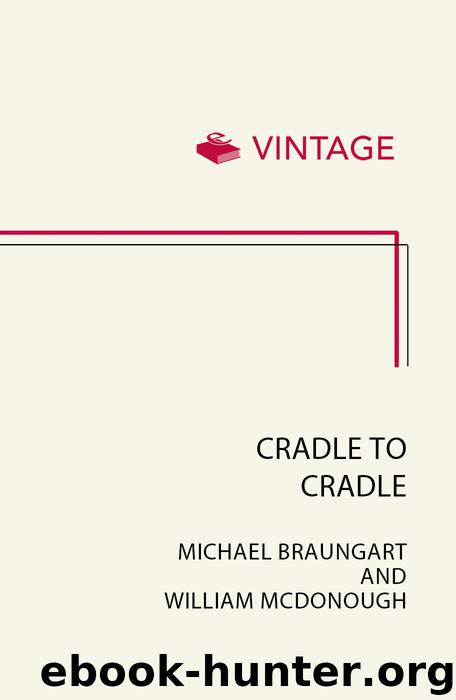Cradle to Cradle: (Patterns of the Planet) by Michael Braungart & William McDonough

Author:Michael Braungart & William McDonough [Braungart, Michael]
Language: eng
Format: azw3
Publisher: Random House
Published: 2009-01-29T05:00:00+00:00
Monstrous Hybrids
Mountains of waste rising in landfills are a growing concern, but the quantity of these wastes—the space they take up—is not the major problem of cradle-to-grave designs. Of greater concern are the nutrients—valuable “food” for both industry and nature—that are contaminated, wasted, or lost. They are lost not only for lack of adequate systems of retrieval; they are lost also because many products are what we jokingly refer to as “Frankenstein products” or (with apologies to Jane Jacobs) “monstrous hybrids”—mixtures of materials both technical and biological, neither of which can be salvaged after their current lives.
A conventional leather shoe is a monstrous hybrid. At one time, shoes were tanned with vegetable chemicals, which were relatively safe, so the wastes from their manufacture posed no real problem. The shoe could biodegrade after its useful life or be safely burned. But vegetable tanning required that trees be harvested for their tannins. As a result, shoes took a long time to make, and they were expensive. In the past forty years, vegetable tanning has been replaced with chromium tanning, which is faster and cheaper. But chromium is rare and valuable for industries, and in some forms it is carcinogenic. Today shoes are often tanned in developing countries where few if any precautions are taken to protect people and ecosystems from chromium exposure; manufacturing wastes may be dumped into nearby bodies of water or incinerated, either of which distributes toxins (often disproportionately in low-income areas). Conventional rubber shoe soles, moreover, usually contain lead and plastics. As the shoe is worn, particles of it degrade into the atmosphere and soil. It cannot be safely consumed, either by you or by the environment. After use, its valuable materials, both biological and technical, are usually lost in a landfill.
Download
This site does not store any files on its server. We only index and link to content provided by other sites. Please contact the content providers to delete copyright contents if any and email us, we'll remove relevant links or contents immediately.
| Automotive | Engineering |
| Transportation |
Whiskies Galore by Ian Buxton(41712)
Introduction to Aircraft Design (Cambridge Aerospace Series) by John P. Fielding(33011)
Small Unmanned Fixed-wing Aircraft Design by Andrew J. Keane Andras Sobester James P. Scanlan & András Sóbester & James P. Scanlan(32678)
Craft Beer for the Homebrewer by Michael Agnew(18076)
Turbulence by E. J. Noyes(7888)
The Complete Stick Figure Physics Tutorials by Allen Sarah(7258)
Kaplan MCAT General Chemistry Review by Kaplan(6814)
The Thirst by Nesbo Jo(6748)
Bad Blood by John Carreyrou(6468)
Modelling of Convective Heat and Mass Transfer in Rotating Flows by Igor V. Shevchuk(6349)
Learning SQL by Alan Beaulieu(6152)
Weapons of Math Destruction by Cathy O'Neil(6077)
Man-made Catastrophes and Risk Information Concealment by Dmitry Chernov & Didier Sornette(5870)
Digital Minimalism by Cal Newport;(5576)
Life 3.0: Being Human in the Age of Artificial Intelligence by Tegmark Max(5398)
iGen by Jean M. Twenge(5298)
Secrets of Antigravity Propulsion: Tesla, UFOs, and Classified Aerospace Technology by Ph.D. Paul A. Laviolette(5232)
Design of Trajectory Optimization Approach for Space Maneuver Vehicle Skip Entry Problems by Runqi Chai & Al Savvaris & Antonios Tsourdos & Senchun Chai(4949)
Electronic Devices & Circuits by Jacob Millman & Christos C. Halkias(4859)
